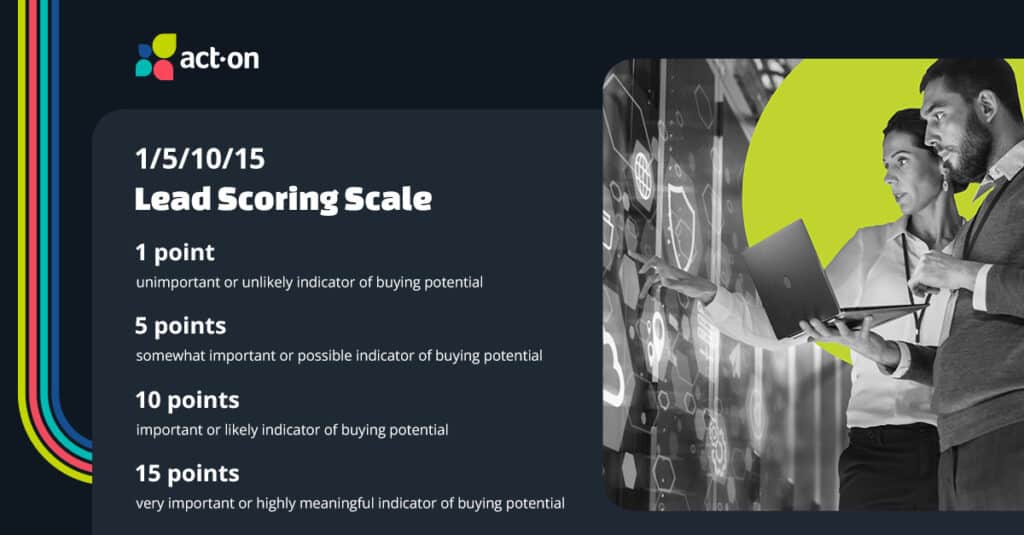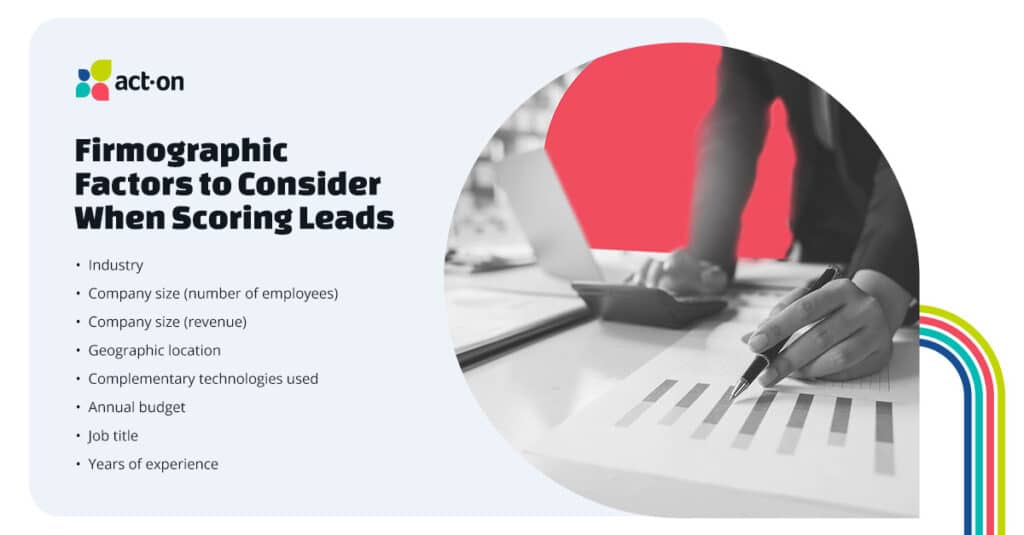Now that we’ve covered the basics of lead scoring, let’s talk about building your own lead scoring model. Designing a lead scoring model seems like a complex proposition. And if you jump into it without a solid strategy in place, you aren’t going to see game-changing results (or a happy sales team). So let’s break it down. There are clear steps you need to take to build and implement a lead scoring model:
Assemble your cross-functional squad
As we mentioned earlier, lead scoring is a team sport. It’s only useful when all the relevant players are aligned, bought-in, and using the framework on a daily basis. So before you start assigning points and determining thresholds, recruit active participants to help develop your lead scoring framework from the ground up.
In addition to marketing and sales, Suzy Balk, our Sr. Marketing Campaigns Manager, advises that product teams should be included in lead scoring. “If you’re releasing new products or features, it’s important to know what those are because you want to pull in the people who will find them most valuable. So loop in Product, because they will have those insights.”
Know your persona
First things first: make sure your sales, marketing, and other relevant teams (like product) are in agreement on what your ideal customer looks like. This means having well-documented and up-to-date ideal customer profiles (ICP) and buyer personas, which will be essential in step five.
Define your ICP
Think of your ICP like the bullseye in the center of a dartboard. It’s the kind of company you’re going to aim for: the most likely size, industry, and location to benefit from (and buy) your product and services.
You won’t only sell to those kinds of companies — just like you’ll hit the segments surrounding the bullseye during a game of darts — but you’ll prioritize them in your lead scoring by assigning them the highest points.
Create your buyer personas
Your buyer personas are imagined biographies based on firsthand experience, market research, and customer listening. They describe the individuals working at your ICP companies, and give sales and marketing teams a fictionalized human to target with messaging, content, and campaigns.
They also give you a target for lead scoring: you’ll assign points to prospects who most closely resemble your buyer personas when it comes to job title, location, experience level, and other demographic details.
Create a customer journey map
Just as you need to know who you’re trying to reach, you need to know where they interact with your brand along their buying journey. Get everyone aligned with a clear customer journey map: a picture of the most important touch points they encounter and steps they take as they move from would-be lead to loyal customer.
Customer journey maps include steps like:
- Downloading a comparison tool
- Reading an ebook
- Checking out a pricing page
- Contacting the sales team or requesting a demo
- Completing a purchase
- Renewing a subscription
The most effective customer journey maps also represent the customer’s mindset or emotional state at each stage, highlighting potential pain points or concerns that marketers can address. These maps can be incredibly simple or very complex, with layers in a heavily matrixed spreadsheet, but having one in place will make assigning behavioral scores in step six much easier.
Plus, companies that use customer journeys are twice as likely to outperform competitors that don’t, likely because it helps teams hone their messaging and content to answer specific needs and questions that arise during the buying process.
Set your lead score scale
Let’s be real here: in a lead scoring model, the numbers are entirely made up. The whole framework hinges on the relative importance of each piece of information or behavior.
You’re trying to answer one question: How important is this factor in terms of indicating likelihood to purchase?
So before you start assigning points willy-nilly, get a reasonable scale in mind. Are you scoring each datapoint on a scale of 1-5? 1-100?
If you’re new to lead scoring, we suggest keeping it simple with a 1/5/10/15 scale:

Keep in mind, you’ll also be assigning negative lead scoring points (-1, -5, -10, etc.) to certain attributes or behaviors that indicate a prospect is highly unlikely to buy.
Assign demographic and firmographic scoring factors
Now’s the time to put your ICP and buyer persona data into play. Assign your relative scores for the attributes that matter most to your business, such as:

Remember our two imaginary Act-On leads, Debbie (the marketing director) and Tyson (the small business owner)? Let’s score their hypothetical explicit data:
Debbie, the Director of Marketing
- Manufacturing industry: 10 points (this industry is undergoing a digital transformation, so we’re seeing a lot of interest from these companies right now)
- 2000-person company: 10 points (pretty close to our ICP)
- “Director of Marketing” title: 15 points (exactly matches up with our buyer personas)
Tyson, the small business owner
- Restaurant industry: 1 point (not totally irrelevant, but not our ICP)
- 1-person company: -15 points (solo entrepreneurs don’t usually have much budget for marketing software)
- “Owner” title: 1 point (too general to tell us much about the individual, and not one of our buyer personas)
Make your list of firmographic and demographic lead scoring factors as comprehensive as possible for your business, and remember — you can always come back and update your framework later. Do not let perfection get in the way of progress, especially if you’re just getting started.
Assign behavioral lead scoring factors
This is where, in our biased opinion, the lead scoring model really gets fun. By tracking behavior over time, you can assess how interested a lead is in your product, how far along they are in that buyer’s journey, and whether they’re ready to stop reading and start talking.
“Most companies are going to have top-of-funnel content to establish themselves as thought leaders,” says Suzy. “A one-time download of that kind of content doesn’t mean anything from a sales-readiness perspective. If it happens, consistently, now that’s a different story — and that’s where lead scoring comes in.”
Pull out your customer journey map and start to assign points to the different behaviors you can track for your leads. Prioritize the steps that matter most for your business, and get specific about which behaviors show the strongest signal of interest in purchasing:
- Events or webinars
- Registration: medium signal of interest
- Attendance: stronger signal (because showing up demonstrates a more serious interest than merely signing up)
- Website visits
- Homepage: low signal
- About page: medium signal
- Pricing page: stronger signal
- Careers page: negative signal (this person wants a job, not to buy your product)
- Content downloads
- Introductory guide: low signal
- Thought leadership or trends content: low signal
- Strategic how-to content (not product-specific): medium signal
- Product comparison: strong signal
- Product implementation guide: stronger signal
- Traffic or referral sources
- Organic search (product-specific term): medium signal
- Organic search (non-product term): low signal
- Linked from product review site: strong signal
- Customer referral: strong signal
- Social media interactions
- Post like: low signal
- Page follow: low signal
- Tradeshow booth visits
- Scanning badge for a raffle entry: low signal
- Engaging in lengthy conversation: medium or strong signal, depending on the context
- Demo requests
- This is usually a “go straight to sales” action, and should immediately surpass your MQL threshold (more on that in a moment).
Let’s look at another lead scoring example with Debbie and Tyson. Here’s how we would score their implicit data, respectively:

Don’t neglect negative lead scoring
We’ve mentioned negative lead scoring above, but it bears repeating: use negative points to keep unqualified leads out of your sales team’s workflows.
Here are a few more examples of when to apply negative lead scores:
Job titles
A “student” is probably not your buyer persona, and likely warrants a negative score. But an “intern” may be doing research for their employer, and shouldn’t be disqualified altogether.
Missing key data points
If a lead leaves important fields blank, like a phone number or company name, they likely aren’t ready for a conversation.
Email domains
Instead of requiring a business email domain to download content, simply use negative scoring to de-prioritize leads who use personal or .edu emails. You can also de-prioritize leads from your existing customers’ email domains (they would be relevant for customer success, but not sales) or competitors’ domains (you can’t stop the spies from checking out your content, but you can make sure they don’t waste your sales team’s time).
Location
If you don’t provide your service or product to their location, they will never be your customer — so downgrade their lead score accordingly.
Need more ideas? Just ask your SDRs. They know what red flags to look for, and will be delighted to share their expertise.
Set your MQL threshold
This is it. The big moment. Time to set your threshold: how many points should a marketing lead accrue in your lead scoring model before they’re ready to hand over to sales?
Pro tip: make sure this decision is not made in a silo.
Take a look at your assigned points and start doing math on your meeting room whiteboard or your favorite remote collaboration tool. Mock up some scenarios in your shared spreadsheet.
Get sales and marketing to agree:
- How many bottom-of-funnel content downloads?
- How many email clicks?
- Which industries?
- What job titles?
- When are these leads ready to talk to sales?
Once you have the answer, set your MQL threshold.
Adjust your direct-to-sales activities
Now, go back and look at your behavioral lead scoring again. Some of these activities might be direct triggers to sales, such as requesting a demo or filling out a “contact us” form. Adjust that relative scoring to your MQL threshold to ensure every lead who raises their hand to talk to sales does exactly that.
Account for leads that return to marketing
Even with the best lead scoring model in place, certain leads will be handed over to sales that aren’t quite ready to purchase. Maybe they’re highly interested in your product, but are under contract with a competitor for another year. Maybe they provided misleading information when filling out their forms, or don’t have the budget. And maybe they just never answer an email or phone call, going radio silent for no discernible reason.
Unless the sales team disqualifies those leads, they are typically returned to marketing for continued nurturing. In that case, Suzy suggests implementing a “cooling off” period before a lead can be handed off to sales again. “For us, when you’re returned to marketing, you can’t return to sales for 120 days,” he says. Their lead-scoring slate is wiped clean, and they can’t reach MQL status until that time window is up — unless they fill out a demo form.
Evaluate, adjust, and repeat
Congrats! Check the box and give yourself a cookie. You’re all done with lead scoring. Forever.
Just kidding. Lead scoring is not a set-it-and-forget-it program. It’s an ongoing process — and that’s why it works so well.
“The great thing about lead scoring is that it’s a model,” says Suzy. “So after you get some results in, you can always go back and make adjustments. You don’t have to — and shouldn’t be trying to — find the perfect model that will work forever.”
Continue to work with your cross-functional lead scoring squad to monitor progress, track success, and refine your model over time.
How to evaluate lead scoring metrics
Get continual feedback from your sales team on how the lead scoring model is working — both qualitative and quantitative.
To gather qualitative input, have regular meetings, ask about specific channels and campaigns, and keep a conversation going between sales and marketing about what’s working and what’s not.
To measure quantitative success, build a disposition into your CRM that requires specific input from sales when they disqualify a lead. Suzy advises making this field a dropdown list of set options, rather than an open text field, to make analysis easier.
“Maybe the company is too small, maybe the title wasn’t a good fit after all, or maybe they seemed like they weren’t a real person because the SDR couldn’t find them on LinkedIn,” says Suzy. “Here at Act-On, we have a definitive list of possible status reasons that we ask the sales team to use, and a notes field where we can capture additional data.”
Suzy also suggests paying close attention to opportunity creation metrics. By tracking what factors are common across leads that are successfully turned into opportunities, you can identify what factors should be weighed more heavily in future lead scoring.
For example, if the data shows that a large percentage of your opportunities are created within a certain industry, you can go back and adjust your lead scoring to rate that industry highly. Suzy recommends evaluating job titles regularly, too.
“It’s common for companies to prioritize VPs and the C-suite in their lead scoring,” says Suzy. “But I wouldn’t even call those roles ‘decision-makers’. More often than not, a manager or a director makes the call, and brings their decision to the C-suite for approval. So you might be scoring high on the VPs and C-suite, but they typically aren’t the ones who start, engage, and move the buying process forward. And you won’t know that’s the case unless you look at the opportunities and see where they’re being created.”
When to adjust lead scoring
Suzy recommends a regular cadence for updating your lead scoring model—at least quarterly. “Look at your lead scoring regularly and make sure that you’re accounting for changes in the business, new products being released, or larger shifts like a recession.”
Look forward to our next article in this series, where we’ll round up the best lead scoring tools to use in your marketing!
